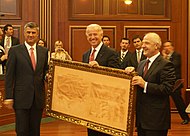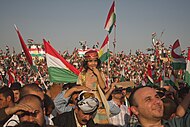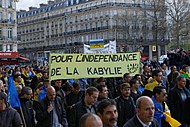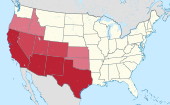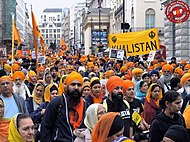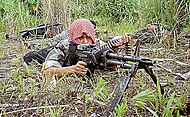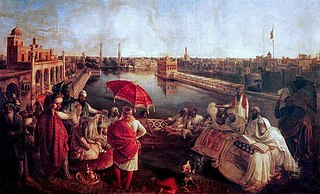
Sikhs are an ethnoreligious group who adhere to Sikhism, a religion that originated in the late 15th century in the Punjab region of the Indian subcontinent, based on the revelation of Guru Nanak. The term Sikh has its origin in the Sanskrit word śiṣya, meaning 'seeker', 'disciple' or 'student'. According to Article I of Chapter 1 of the Sikh Rehat Maryada, the definition of Sikh is: Any human being who faithfully believes in
- One Immortal Being
- Ten Gurus, from Guru Nanak Sahib to Guru Gobind Singh Sahib
- The Guru Granth Sahib
- The utterances and teachings of the ten Gurus and
- The initiation, known as the Amrit Sanchar, bequeathed by the tenth Guru and who does not owe allegiance to any other religion, is a Sikh.
Hindutva is a political ideology encompassing the cultural justification of Hindu nationalism and the belief in establishing Hindu hegemony within India. The political ideology was formulated by Vinayak Damodar Savarkar in 1922. It is used by the Rashtriya Swayamsevak Sangh (RSS), the Vishva Hindu Parishad (VHP), the Bharatiya Janata Party (BJP) and other organisations, collectively called the Sangh Parivar.
Secession is the formal withdrawal of a group from a political entity. The process begins once a group proclaims an act of secession. A secession attempt might be violent or peaceful, but the goal is the creation of a new state or entity independent of the group or territory from which it seceded. Threats of secession can be a strategy for achieving more limited goals.

The Khalistan movement is a separatist movement seeking to create a homeland for Sikhs by establishing an ethno‐religious sovereign state called Khalistan in the Punjab region. The proposed boundaries of Khalistan vary between different groups; some suggest the entirety of the Sikh-majority Indian state of Punjab, while larger claims include Pakistani Punjab and other parts of North India such as Chandigarh, Haryana, and Himachal Pradesh. Shimla and Lahore have been proposed as the capital of Khalistan.
Religious nationalism can be understood in a number of ways, such as nationalism as a religion itself, a position articulated by Carlton Hayes in his text Nationalism: A Religion, or as the relationship of nationalism to a particular religious belief, dogma, ideology, or affiliation. This relationship can be broken down into two aspects: the politicisation of religion and the influence of religion on politics.

Jarnail Singh Bhindranwale was a Sikh militant. He was the leading figure of the Khalistan movement, although he did not personally advocate for a separate Sikh nation.
Regionalism is a political ideology that seeks to increase the political power, influence and self-determination of the people of one or more subnational regions. It focuses on the "development of a political or social system based on one or more" regions and/or the national, normative or economic interests of a specific region, group of regions or another subnational entity, gaining strength from or aiming to strengthen the "consciousness of and loyalty to a distinct region with a homogeneous population", similarly to nationalism. More specifically, "regionalism refers to three distinct elements: movements demanding territorial autonomy within unitary states; the organization of the central state on a regional basis for the delivery of its policies including regional development policies; political decentralization and regional autonomy".
Black separatism is a separatist political movement that seeks separate economic and cultural development for those of African descent in societies, particularly in the United States. Black separatism stems from the idea of racial solidarity, and it also implies that black people should organize themselves on the basis of their common skin color, their race, culture, and African heritage. There were a total of 255 black separatist groups recorded in the United States as of 2019.

The Insurgency in Punjab, India was an armed campaign by the militants of the Khalistan movement from the mid-1980s to the mid-1990s. Economic and social pressures driven by the Green Revolution prompted calls for Sikh autonomy and separatism. This movement was initially peaceful, but foreign involvement and political pressures drove a heavy handed response from Indian authorities. The demand for a separate Sikh state gained momentum after the Indian Army's Operation Blue Star in 1984 aimed to flush out militants residing in the Golden Temple in Amritsar, a holy site for Sikhs. Terrorism, police brutality and corruption of the authorities greatly exacerbated a tense situation. By the mid-1980s, the movement had evolved into a militant secessionist crisis due to the perceived indifference of the Indian state in regards to mutual negotiations. Eventually, more effective police and military operations, combined with a policy of rapprochement by the Indian government and the election loss of separatist sympathizers in the 1992 Punjab Legislative Assembly election, largely quelled the rebellion by the mid-1990s.
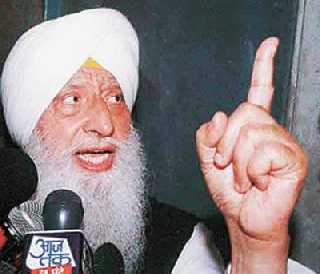
Jagjit Singh Chohan was a major Sikh leader of the Khalistan movement that sought to create a sovereign Sikh state in the Punjab region of the Indian subcontinent. Chohan established the Council of Khalistan at Anandpur Sahib on 12 April 1980 and became its first self‐styled president.

The Sindhudesh Movement is a separatist movement, based in Sindh, Pakistan, seeking to create a homeland for Sindhis by establishing an ethnic state called Sindhudesh, which would be either autonomous within Pakistan or independent from it.
In 2010, South Asia had the world's largest population of Hindus, about 510 million Muslims, over 27 million Sikhs, 35 million Christians and over 25 million Buddhists. Hindus make up about 68 percent or about 900 million and Muslims at 31 percent or 510 million of the overall South Asia population, while Buddhists, Jains, Zoroastrians, Sikhs, and Christians constitute most of the rest. The Hindus, Buddhists, Jains, Sikhs, Zoroastrians, and Christians are concentrated in India, Nepal, Sri Lanka and Bhutan, while the Muslims are concentrated in Afghanistan (99%), Bangladesh (91%), Pakistan (96%) and Maldives (100%).
Secession in India typically refers to state secession, which is the withdrawal of one or more states from the Republic of India. Whereas, some have wanted a separate state, union territory or an autonomous administrative division within India. Many separatist movements exist with thousands of members, however, some have low local support and high voter participation in democratic elections. However, at the same time, demanding separate statehood within under the administration of Indian union from an existing state can lead to criminal charges under secession law in India. India is described as an ‘Union of States’ in Article 1 of the Indian constitution I.e "Indestructible nation of destructible states" by its father of constitution Dr. Bhimrao Ramji Ambedkar where a state or Union territory of India cannot secede from India by any means and the Central Government has more powers than the respective state governments and can forcefully change the names and boundaries of the states without their permission at any time when needed for self interest and for the maintenance of integrity.

The Inner Mongolian independence movement, also known as the Southern Mongolian independence movement, is a movement for the independence of Inner Mongolia and the political separation of Inner Mongolia from the People's Republic of China. It is principally led by the Mongolian diaspora in countries like Japan and the United States, and in some European countries.
Punjabi nationalism is an ideology which emphasizes that the Punjabis are one nation and promotes the cultural unity of Punjabis around the world. The demands of the Punjabi nationalist movement are linguistic, cultural, economic and political rights.

Sikhs for Justice (SFJ) is a US-based group that supports the secession of Punjab from India as Khalistan. Founded and primarily headed by lawyer Gurpatwant Singh Pannun in 2009, the organization was created in response to the murders of Sikhs after Prime Minister Indira Gandhi was assassinated by her Sikh bodyguards.

This article relates to historical and current separatist movements within Australia. Separatism conventionally refers to full political separation, including secessionism; groups simply seeking greater autonomy are not separatist as such.

